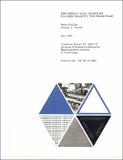| dc.contributor.author | Griffith, P. | en_US |
| dc.contributor.author | Snyder, George A. | en_US |
| dc.contributor.other | Massachusetts Institute of Technology. Division of Sponsored Research. | en_US |
| dc.contributor.other | Massachusetts Institute of Technology. Heat Transfer Laboratory. | en_US |
| dc.date.accessioned | 2011-03-04T23:36:45Z | |
| dc.date.available | 2011-03-04T23:36:45Z | |
| dc.date.issued | 1964 | en_US |
| dc.identifier | 14072541 | en_US |
| dc.identifier.uri | http://hdl.handle.net/1721.1/61488 | |
| dc.description.abstract | A possible mechanism for the transition between bubbly and slug flow is proposed and tested in a simulated slug flow system. No sudden collapse of slug flow with increasing velocity is found and it is concluded that: a. Slug flow is generally stable at voids greater than 35%. b. Bubbly flow at voids higher than this is a result of entrance conditions. c. Visual observations of bubbly flow in unheated systems at higher voids are most likely faulty. No simple asymptote limit or criterion that would predict the location of the bubbly-slug transition was found. | en_US |
| dc.description.sponsorship | Sponsored by the U. S. Atomic Energy Commission DSR | en_US |
| dc.format.extent | [35] leaves in various pagings (some unnumbered) | en_US |
| dc.publisher | Cambridge, Mass. : M.I.T. Division of Sponsored Research, [1964] | en_US |
| dc.relation.ispartofseries | Technical report (Massachusetts Institute of Technology, Heat Transfer Laboratory) ; no. 29. | en_US |
| dc.subject | Bubbles. | en_US |
| dc.subject | Pipe -- Fluid dynamics. | en_US |
| dc.subject | Heat -- Transmission. | en_US |
| dc.title | The bubbly-slug transition in a high velocity two phase flow | en_US |
| dc.type | Technical Report | en_US |
